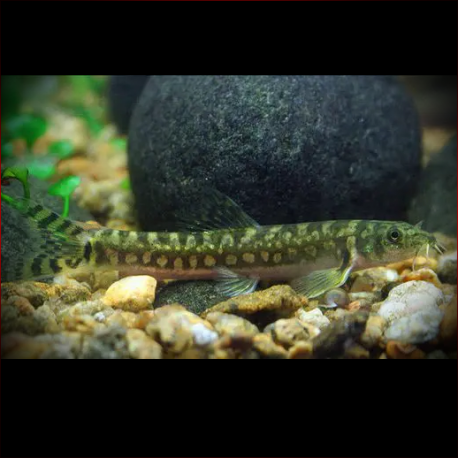More info
Datasheet
| Minimum Tank Size | 60 litres / 15.85 US gallons |
| Maximum Size | 6.0cm / 2.36inches |
| Temperature | 18°C / 64.40°F - 25.5°C / 77.90°F |
| Hardness | 2.02dgH / 36ppm - 12.05dgH / 215ppm |
| pH | 6.0-7.5 |
General Description
Mesonoemacheilus herrei is a small, peaceful loach species which is relatively reclusive in nature. It has a distinctive body patterning with rows of yellowish, dark-edged spots that set it apart from other species in its genus. It is an omnivorous species with a diet primarily consisting of small insects, worms, crustaceans, and zooplankton.
Aquarium Setup
When setting up an aquarium for M. herrei, it is crucial to replicate its natural habitat of well-oxygenated, headwater streams. This includes using a substrate of coarse sand, gravel, rocks, and boulders covered in algae and other microorganisms. Aquatic plants are usually absent, but hardy species like Microsorum, Bolbitis, or Anubias can be added. Maintaining high levels of dissolved oxygen and water movement is essential, requiring power filters, powerheads, or airstones. Regular water changes of 30-50% are recommended to keep the tank clean.
Behaviour
In the aquarium, M. herrei is relatively peaceful with its own species and benefits from being kept in groups of four or more individuals. It is known to exhibit confidence when in the presence of other small, open water-dwelling cyprinids, making them excellent tank mates. However, it is best to avoid combining them with sedate bottom-dwellers like Corydoras catfish.
Feeding and Diet
This species is omnivorous, with a diet that includes small insects, worms, crustaceans, and zooplankton. In captivity, they readily accept small live and frozen foods such as Daphnia, Artemia, and bloodworms, which contribute to their optimal coloration and health. While they can consume dried foods, a varied diet is essential for their well-being.
Reproduction & Dimorphism
Little is known about the reproduction of M. herrei in captivity, but success with a closely related species has been reported. Adult females may grow slightly larger and rounder-bellied when gravid, while males develop thickened pectoral-fin rays and tubercles when sexually mature. The species is noted for its peaceful nature with conspecifics and preference for group living.
Habitat and Distribution
Mesonoemacheilus herrei is native to the Anaimalai Hills range of the Western Ghats mountains in southern India. It inhabits clear, well-oxygenated streams with substrates of sand, gravel, and rocks. This region is part of a biodiversity hotspot, home to various endangered species, including iconic wildlife like elephants and tigers. The species has not been widely exported for the aquarium trade, possibly due to its specific habitat requirements and reclusive nature.

